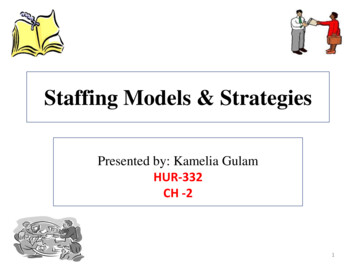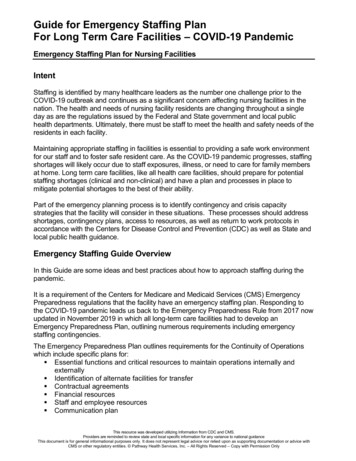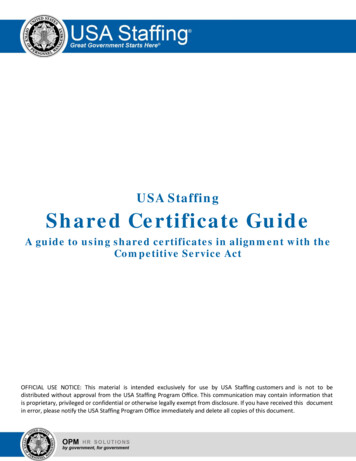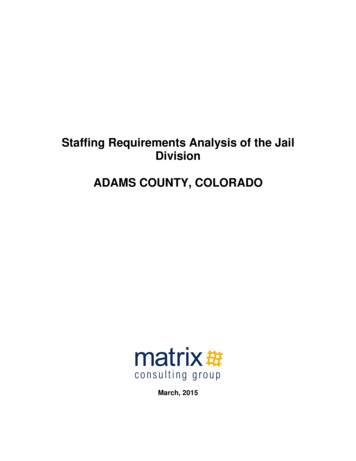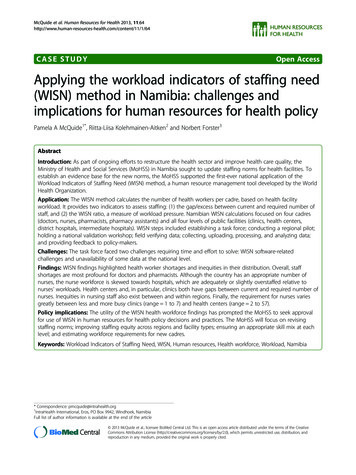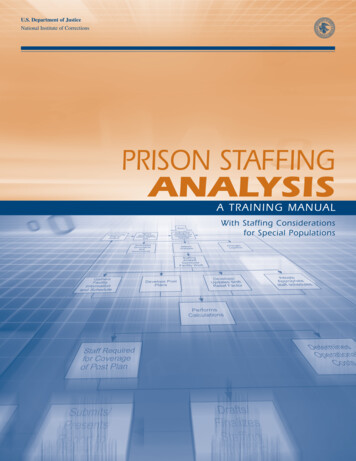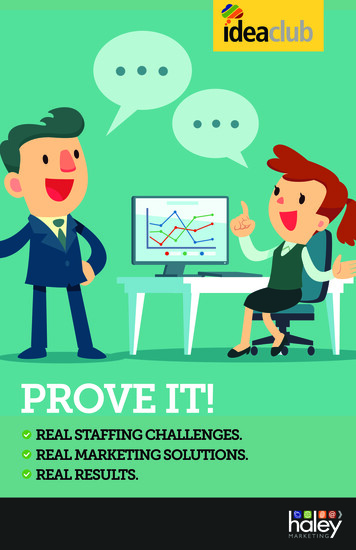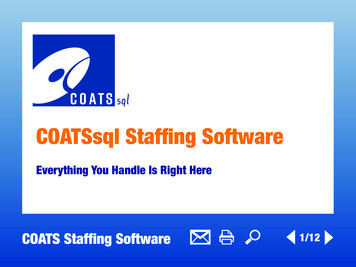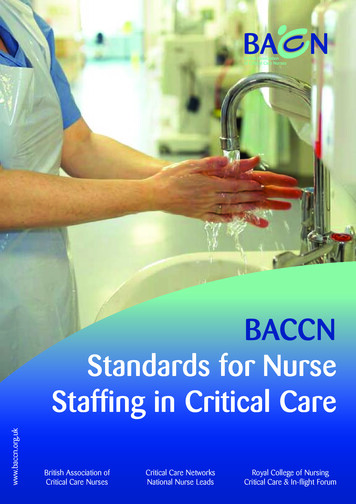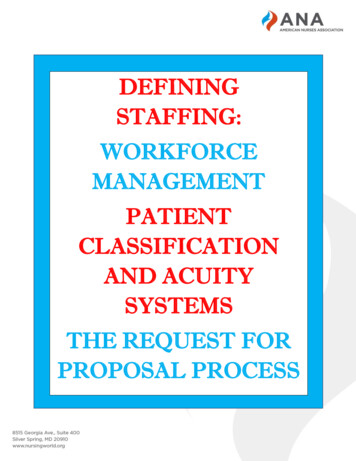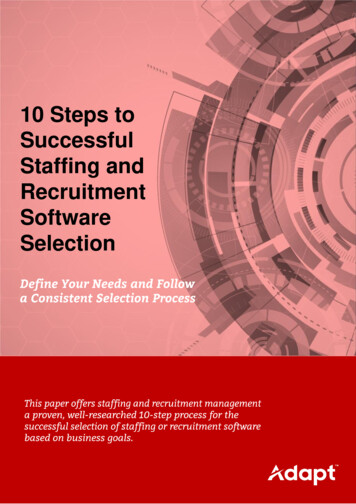
Transcription
10 Steps toSuccessfulStaffing andRecruitmentSoftwareSelection
Contents34467889101111122 Introduction Choose a selection strategy and a selection team Map your company priorities and business requirements Define your company structure and climate for change Identify internal resources and technology infrastructure Create a list of potential vendors Contact vendors and compare product demos Identify the top three contenders Obtain pricing from the top contenders Obtain References Finalize your decision and implement the system SummaryTitle of the book
10 Steps to Successful Staffing andRecruitment Software SelectionTechnology advances at a dizzying pace. Ten yearsago ‘social media recruitment’ via online social networkswas only an idea in some entrepreneurial minds. Today itis a mainstay for tech-savvy recruitment and staffingprofessionals. W ith ongoing advances and an eye on thefuture, the recruitment industry must continually adapt toprovide faster, better services than ever before.Staffing and recruitment software plays a crucial role in the continued success of agencies. It is, as onestaffing agency owner said, “the lifeblood of our company,” enabling the effective management of themany complex business relationships between clients and candidates.So it is with understandable anxiety that agency management considers upgrading the technology theyalready have in order to keep up with or improve their fortunes in today’s sophisticated and competitiveenvironment. Today, measuring quality, increasing productivity, and being operationally efficient are allimportant in the business of making placements and filling jobs.Choosing the best staffing or recruitment software product to meet your agency’s specific needs andgoals can be a formidable task. The stakes are high.You need a vendor partner that delivers solutions, not just features.To some, choosing the “best” system consists of looking at all the vendor software packages and buyingthe one with the most or newest bells and whistles. W ith so many products available on the market, it’simportant to look much deeper than what the software may offer – you need to look at the partnershipyou’ll be entering into as well.Most importantly, clarifying the selection process begins with the simple recognition that the best systemfor your organization is the one that provides real solutions to the challenges you now face and will helpyou reach the goals you are trying to achieve. An analysis of those goals will provide the framework forsetting the criteria for system selection and will lend credence to the process for you and your staff. Astructured business analysis will yield a list of requirements that you can use to compare thefunctionality of various software packages.The 10-step approach that follows for selecting staffing and recruitment software should reduce thestress of the selection process and ensure that your final choice will help you meet your goals.310 Steps to Successful Staffing and Recruitment Software Selection
1. Choose a Selection Strategy and a Selection TeamHow you will make your decision? Charting a strategy before you begin willmake the process easier and will enable involved personnel to visualize theend result more clearly. W ithout a detailed plan, the process can becomenever-ending. You need to decide: Who will be involved in the selection process? What part will each person play? What steps will you take? How will the final decision be made? Who will make the final decision? When do you plan to make the final decision? What is your budget?Deciding whom to involve is probably simple. Your decision to look for anew recruitment software solution probably began with both business andtechnical factors. The people involved in those issues are the most likelyplayers in the selection process. Involving key stake-holder representativesfrom your sales, recruiting, accounting, and technical staff will lend balanceto the final decision and create buy-in from all constituents.2. Map Your Company Priorities and BusinessRequirementsWhat are your priorities?Software should help you meet your company’s goals. The three biggestreasons to even consider looking at upgrading or replacing your currentrecruitment software solution are: Your business is not achieving its performance goals due to theinefficiencies caused by your current system.You believe that the system will not be able to meet your businessgoals due to lack of features, functions, scalability, business strategychanges, etc.Your current system is putting you at a competitive disadvantage. Defining those goals will provide a better foundation for understanding howsoftware can provide solutions. Begin by identifying your top priorities basedon the primary roles of front-line staff and management, such as the partiallist of typical goals below.GOAL/PRIORITYImprove sales repsales closure ratesImprove recruitertime-to-fill rates andplacementsImprove operatingand service efficiency4SOFTWARE FEATURES Unified user interface to reduce effort related toprocesses. Prioritization and management of sales activities. Easy means to collaborate and manage pipelines. Mobile capabilities to improve ease of response. Intuitive user interface to improve productivity. Easy management of candidates and contacts. Fast, easy search and order/requisition fulfillment. Cloud-based, web-browser Software-as-a-Service(SaaS). Reduce data entry effort, errors, and expenses withintegrated client invoicing and temp/contract payroll. Dashboards and reporting provides actionable insightsfor collaboration, pipeline management, andoperations. Enables the implementation of configurable workflows.Selection TipAlways focus on ‘WHY’something is importantwhen determining yourbusiness priorities andrequirements. If youcan, attach a monetaryvalue to the priority orbusiness requirement.10 Steps to Successful Staffing and Recruitment Software Selection
Determine Your Business Requirements: What do youwant to fix or preserve?First you need to identify the processes you may want tochange or preserve, such as: Applicant entry - where and how is it done?Method of capturing candidate skills - coding vs. CVsearching and parsingCompany/client ownership - what rules are in place?Job order information and evaluation - what questions areasked that must be documented? What rankings andother criteria are utilized?Back office processes - how will temp/contract payroll andclient invoicing be handled?Management reporting - what reporting is required,desired and optimal?Integrations - what other data sources and/or third partyapplications must be integrated to efficiently supportoperating business processes and/or strategies?Once you have recognized the processes that should be fixed or preserved, then, based onthe results of the previous steps, compile your list of business requirements. This can be donein spreadsheet form for easy use during the software evaluation process. List each requirement you have identified. Rate each item in terms of necessity:o 3 Must have, will not sacrifice.o 2 Will sacrifice if necessary.o 1 Nice to have. Add other features you would like, assigning the appropriate rating. Lay out your requirements in a five column grid, with the columns labeled:o Rating.o Requirement.o Functionality.o Advantages.o Disadvantages.Add additional rows for pricing, support services, references and business partnership issues. Younow have a grid or template of your business needs and system requirements that you can use witheach system you wish to evaluate.510 Steps to Successful Staffing and Recruitment Software Selection
3. Define Your Company Structure and Climate for ChangeThe current structure of your organization and your plans for the future can eachinfluence your choice of a system. Consider your: Number of office locations, current and projected.Service areas: perm, temp, contract.Market niches and specific needs of the markets you serve.Need to share information across databases.Need to share information across locations, divisions or teams.Some software systems are well equipped to handle multiple disciplines or officelocations; others are not. Some systems are clearly geared towards permanent,tempory or contract recruitment.Those that do handle a variety of disciplines do so with varying degrees ofsuccess. If yours is a firm that has more than one service offering, the ability tohandle those offerings seamlessly will be a major factor in your consideration ofsoftware systems.Is your company ready for the impact of change?Installing a new software system, whether replacing your current system or goingthrough a major upgrade, creates the opportunity to re-engineer your businessprocesses. Just attempting to mirror your current processes may deny you theopportunity to gain significant efficiencies and productivity enhancements.In addition, a new system may produce a temporarily negative impact onproductivity, as staff adjust to the changes. The size of that impact depends onyour staff’s attitude. When staff are inclined to embrace change, chances are thata new system will show a positive effect quickly; when staff resist change, theopposite can be true. Consider your staff’s tenure and how many changes they have been through –management, organization, physical office moves, process changes, etc. Howwell have they dealt with the issues surrounding those changes? Examine your own attitude toward change. Do you believe that your “tried andtrue” methods are the best and that change would be a mistake? Or do youbelieve that processes should be malleable based on strategic goals? What is the level of your staff’s technical ability? Are they likely to embrace anew technological solution or will they be intimidated?Selection TipA fresh look at yoursales, recruitment, andoperating processescan help you uncoverand address areas forimprovement. A newsoftware system canthen be a positivecatalyst for change inthese processes.If you determine that your organization has a high quotient for change, thestructure of the system you choose will be less of a factor, giving you more roomto implement new processes. If, on the other hand, you wish to preserve yourcurrent processes by automating them, you need to look for the system that mostclosely mirrors those processes, or one that allows configuration or customization.Even so, keep in mind that your business strategies and processes may changeover time. Starting up a new line of business would require changes in yoursoftware processes as well. W ith that consideration, a system offering theflexibility to change as your business changes is vital.Importantly, you will reduce the impact of change on your staff’s productivity withgood training and communicating to your staff the benefits of the change to thempersonally.610 Steps to Successful Staffing and Recruitment Software Selection
4. Identify Internal Resources and Technology InfrastructureThe success of any software implementation depends on the ability to keep thesystem running smoothly, both technically and operationally. In addition, training,change management and operational issues need to be handled.Identify your internal resources – people and infrastructure – for accomplishing thesetasks. The degree to which you can handle them internally may affect both thecomplexity of the system you choose and your need for vendor services. Forexample, do you have the internal staff already in place to effectively manage theimplementation and ongoing management of a new system?Your current technology can greatly influence the selection of a software product.Your desire to upgrade or attempt to maintain your existing infrastructure should bebased not only on the investment in hardware and platform that you have alreadymade but also on its ability to grow and accommodate your future plans. Here againis an opportunity to look at your Total Cost of Ownership (TCO) over time. Considerthe following: Do you currently have a server in place? If so, how old is it? Is it depreciated? Is the platform meeting your present needs? Does the current system offer you enough room for growth? Does the current system meet your performance efficiency needs? Are your telecommunications needs being handled currently? Will future plans require added connectivity solutions? Does your budget allow you to upgrade or replace existing infrastructure? Could you reduce your TCO with an On Demand Software as a Service/SaaSsolution?Obviously then, you have choices for the deployment of your new software, fromenterprise systems that you host at your location (On Premise) to On Demandsubscription systems (Software as a Service/SaaS).If you purchase an On Premise enterprise system, software vendors may require thatyou have a dedicated IS person on staff to ensure technical stability andmaintenance of the system on a day-to-day basis. In addition, a new On Premisesystem will often require new server hardware, connectivity services, and new serversoftware.Simplifying the implementation and offering attractive TCO, businesses of all sizesare increasingly choosing On Demand SaaS systems to upgrade to from their currentsystems. However, it’s important to keep in mind that SaaS comes in a variety ofdeployment methods, which can have a significant impact on the cost, delivery,flexibility, reliability, performance, and configurability of the software.Selection TipGenerally, businessesreplace computerservers and user PC’sor laptops every 3-5years. Doing so willgive you a measurableboost in performance,especially whencombined with new,more efficient staffingand recruitmentsoftware.For example, multi-tenant SaaS applications may offer low cost and fast set-up, butare not as flexible or configurable as single-tenant SaaS or virtualized systems thatenable software vendors to support multiple tenants in a single hardwareenvironment. When looking at potential cloud-based SaaS vendors, it’s imperative toask about the hosting environment and security. Furthermore, where the actual dataresides geographically is an important issue as you are dealing with private personaldata subject to the laws of the countries you are doing business in.From your technical analysis, determine whether a specific technology is arequirement for your company. If you are starting from scratch or fully replacing yourexisting systems, you may want to consult experts who can provide technicalspecifications to meet your current and projected requirements.710 Steps to Successful Staffing and Recruitment Software Selection
5. Create a List of Potential VendorsYour first list should include six-to-ten vendors that appear to satisfy yourrequirements, enough to provide a good cross-section of functionality withoutoverwhelming you.There are several resources for identifying systems for staffing and recruitment.You can start with a Web search for potential software vendors using suchkeywords as “staffing software” or “recruitment software.” Visiting vendor sites toreview online demos and download brochures and/or white papers will provideenough information for you to begin making a list of the systems that are mostlikely to meet your needs.Recruitment industry trade shows and events are a very good place to get asense of what’s available as well as do comparison shopping between theofferings of several vendors. Word-of-mouth is also an excellent resource. Talkwith your colleagues in the industry; check with staff who may have worked atother services, or consult industry experts.6. Contact Vendors and Compare Product DemosAs you contact vendors, freely discuss your primary requirements, technology needs,overall structure and plans for growth. It is especially important that you share asmuch information as possible about the current challenges you may have with yoursystem as well as your business operations and strategy. The more the vendorknows about your business and your future plans, the more likely it is that they caneffectively help you achieve your business goals.These preliminary conversations will help you decide whether to proceed with eachvendor. When you’ve determined that you would like to know more, arrange for ademo, which may be delivered in various formats: Online Demo. The most effective method of getting an understanding of a softwareproduct is an online demo, where you can watch or participate in a demo of thesoftware over the Internet. This can be extremely useful, as you’ll be guidedthrough the features in which you are most interested. “Sandbox” Demo. Some vendors offer you the opportunity of going online andusing their software in a test environment. While this gives you some hands-onexperience with the user interface, its value is limited without some training tofamiliarize you with using the software. Face-to-face Demo. At some time in the selection process it may be advisable tomeet with the vendor in person, not only to see the product used live with your keystakeholders, but also to ensure that you are joining forces with a business partnerwith whom you can relate and trust.Selection TipUse a ‘Day in the Life’demo for each role inyour organization. Thiswill show how wellunified the software’sfunctionality and easeof-use is for your staff.As you review the products, use the grid that you’ve prepared. Describe the featuresand functionality that pertain to your requirements, and list the advantages anddisadvantages of each vendor’s products.When possible, you or your staff should use the system yourself. There is a bigdifference between watching someone else perform the commands and actuallydoing them yourself. W hat may seem simple when you are watching may be quitecomplicated when you’re the user. The caveat is that, without training and/orguidance, your hands-on experience may be frustrating. Remember that there isalways a learning curve.810 Steps to Successful Staffing and Recruitment Software Selection
Also, you will want to 'dig deeper' with your questions. If you ask a questionabout a process that is important to you, make sure you are shown exactly howit works, or given the ability to test it out for yourself, rather than just beingverbally told it can be done. While not intentionally misleading, an explanationcould be misunderstood or interpreted differently by each member of your team.Relationships matter for long-term success.The quality of the vendor relationship should remain forefront in your mindduring the demo stage. Not only are you purchasing a product that will form thebasis of your business processes, but you are also forming a partnership thatwill last for many years.The nuances that you perceive in the initial stage are likely the kernel of theongoing relationship. You must feel comfortable that you are partnering with acompany that has the same ideals and ethics as your own. In this light, it is avery good idea to visit the vendor’s premises, even if it means a long-distancetrip.7. Identify the Top Three ContendersUsing the grids you have prepared as a guide, you and your committee thenidentify the vendors that meet the greatest percentage of your requirements. It isnot unusual to ask for more demos of a system before reaching this stage.Because every agency has its own objectives and methods, it is important toremember that it is not likely that any one vendor will meet 100 percent of yourneeds. A good rule of thumb is to look for a product that meets 80 percent ofyour needs from a vendor who is your top choice as a long-term partner. Butwhat about the other 20 percent? Make sure the 80 percent is the right 80 percent. The priorities you ranked “3”should be met 100 percent. If your “3”-ranked priorities are not met, askyourself whether you have gained information during the selection processthat compensates for that priority or has even caused you to change yourpriorities. Obtain ideas from vendors or consultants about “work-arounds” – findinguses for which the software was not designed but that it can be made to do.Sometimes these turn out to be so useful that vendors will include them infuture upgrades for all of their clients. Discuss customization or configuration, or the possibility of includingfunctionality you would like in future releases. While customization andconfiguration can be costly, and some vendors are simply not willing to do it,some vendors consider it a good investment of their time and energy to addenhancements you request that may also be beneficial to other customers. Consider how you might change your internal processes to accommodatefunctions that are lacking in the system.Ideally, at this point, you and your committee will agree on the top two to threevendors.910 Steps to Successful Staffing and Recruitment Software Selection
8. Obtain Pricing from the Top ContendersThere is a lot to think through in pricing new software – and it’s not just the costof software. You also have to consider: Software Delivery Method - How do you want to access and use thesoftware?o As an enterprise (self-hosted/On Premise) solution?o As a subscription based On Demand Software as a Service/SaaS?o What are the costs for each? Data Migration Services - Does the vendor offer services to migrate datafrom your old system to their system? If so, what will it cost? Data migration isoften one of the most challenging tasks related to software upgrades.Consider:o Do you have multiple databases to migrate from?o Are the databases all the same type, or do you have multipledatabases used by different departments or teams to be migrated intoone system?o Do you have someone on your team that has the technical knowledgeto understand it's not a simple 'copy and paste' process?o Do you have someone on your team with knowledge of your legacysystem who can assist in the mapping and translations tasks for themigration?o Do you know how you will acquire a backup of data from your legacysystem? Is this something that you can provide, or will you have torequest this from your current vendor? This is required to provide anaccurate cost estimate, and of course for the actual migration itself. Implementation Services - Does the vendor provide assistance withimplementation issues involving the use of the system, definition of fields,values for coded fields and the like? If so, are there additional costs? Installation - Does the vendor provide a full software install? What is thecost? Training - What formats are available? Is there an additional cost, or is itbundled into the total cost? Is ongoing training available? What does it cost? Support Services - What support plans are available, how much do they cost? Upgrade Policies and Costs - How often does the vendor release updatesto the system? Are the updates included in the support contract? Hardware Costs - What upgrades need to take place to your hardware, userstations, and network? Be sure to include servers, workstations, printers,cabling, telecommunication costs, and installation and support services. Additional User Costs - As you add new users, what will be the costs toexpand the software? (Whenever possible, ask the vendor to lock in a peruser upgrade price for a certain period of time.) Internal Technical Support Costs - Will you need to upgrade the skills ofyour internal IT support staff? Will you need to add IT support staff or contractfor outside IT support services? Additional Software Modules - Does the vendor offer other softwaremodules that extend the core applications’ functionality or capabilities? Dothese fit your needs? What do they cost? Additional Services - Does the vendor offer related technology servicessuch as disaster recovery services? Do they fit your needs? Will theseenhance your services and the vendor partnership? What do they cost?10Selection TipDetermine the TotalCost of Ownership(TCO) for the software,hardware, and servicesfor the system that youare looking at overthree-to-five years at aminimum.10 Steps to Successful Staffing and Recruitment Software Selection
9. Obtain ReferencesDo not omit this critically important step. Whenever possible, obtain referencesfrom users whose names were not provided by the vendor. Ad hoc informationcan sometimes be useful as well. We suggest that you ask users of the software: How long have you had the software? What were your reasons for selecting this product? What other software did you evaluate? How many users do you have? What is the structure of your organization? (This establishes similarity to yourorganization.) What services do you offer? Has the product provided the functionality you expected? Has it provided functionality you didn’t expect? Did you have to do your own integration with third-party software? How didthat go? How much support did you get from the vendor? Has the product made your organization more productive? Is there anything you don’t like about the software? How long did it take your staff to become fully functional with the software? How long does it take new users to learn the software? What kinds of problems have you had with the software? What has been your experience with vendor support? Is the vendorresponsive? Are your problems fixed in a timely manner? Would you choose the same vendor if you were buying a system today?10. Finalize Your Decision and Implement the SystemSelecting a new software package for your agency is absolutely one of the mostsignificant business decisions that you will make. Objective and critical analysisof the data you have collected is absolutely essential. You have to compare thetotal package of the functional and beneficial capabilities of the system alongwith the associated costs, references, and your relationship with the vendor.Selection TipThe currency of areference is important.Because software andservices change, youshould only seekreferences who arecurrent users of thesoftware, not those whomay have used thesoftware in the past.Once you have made a choice, finalize pricing with the vendor, negotiate terms,and discuss implementation schedules.System implementation is no small task.You used a well-thought-out and organized approach to system selection. You’llneed to apply the same diligence and forethought to the implementationprocess. A smooth transition depends on scheduling, planning to re-engineeryour business processes and clear communication with staff, vendors andsupport services.Be realistic about the time frame of the implementation project. Do you havespecific deadlines you need to make? What are these deadlines based upon? Ifyou would like to start off on a new system at the beginning of the calendar year,are you prepared for the possibilities of your employees needing to work throughthe holidays? Do you have someone going on holiday or maternity leave?1110 Steps to Successful Staffing and Recruitment Software Selection
Make sure to ask the vendors for example project plans and ask for an estimateon how long your implementation might take. Again, this will depend upon thesize of your business, the number of users, how many different databases youmight be migrating from, and any other internal projects or conflicts that mayarise.In the end, this step-by-step approach to staffing and recruitment softwareselection reduces the stress to you and your organization and enables you toachieve your business goals.Summary: 10 Steps to Successful Staffing and RecruitmentSoftware Selection1. Choose a Selection Strategy and a Selection Team2. Map Your Company Priorities and Business Requirements3. Define Your Company Structure and Climate for Change4. Identify Internal Resources and Technology Infrastructure5. Create a List of Potential Vendors6. Contact Vendors and Compare Product Demos7. Identify the Top Three Contenders8. Obtain Pricing from the Top Contenders9. Obtain References10. Finalize Your Decision and Implement the SystemAcknowledgementsThis paper has been extensively revised and updated by the Erecruit Adapt team toincorporate the latest and most relevant methodologies on staffing and recruitment softwareselection. Erecruit wishes to express its appreciation to Mary Lynn Seaby, currently theSenior Director of Operations for Randstad Finance & Accounting, for her role in developingthe genesis of this paper for Staffing Industry Analysts, Inc., who in turn shared it withErecruit.1210 Steps to Successful Staffing and Recruitment Software Selection
Recruitmentand StaffingSoftware forFast-GrowingFirmsAchieve efficiencies and enhancecross-company collaboration withAdapt’s recruitment software thatensures your staffing firm willsucceed, grow and expand beyondexpectations.An intuitive and powerful solutionfor scaling and fast-growingstaffing firms.
10 Steps to Successful Staffing and Recruitment Software Selection echnology advances at a dizzying pace. Ten years ago 'social media recruitment' via online social networks was only an idea in some entrepreneurial minds. Today it is a mainstay for tech-savvy recruitment and staffing professionals. With ongoing advances and an eye on the
